| Pages:
1
2
3
..
5 |
jdowning
Oud Junkie
    
Posts: 3485
Registered: 8-2-2006
Location: Ontario, Canada
Member Is Offline
Mood: No Mood
|
|
Old Oud compared to Old Lute Geometry
Under the topics "Old Oud - New Project", "Oud or Lute?" and "Analysis of Nahat Bracing" on this forum, the geometries of three oud profiles were
analysed - the 14th C engraving of a 5 course fretted oud in the Kitab al-Adwar, ALAMI's late 19th C Al- Arja oud and the recently restored early 20th
C George Abdo Nahat & Sons oud. (see those threads for more detailed information).
The task now is to see if there might be any correlation between these geometries and those of surviving European lutes of the 16th and 17th C.
Over the years since I started out making lutes in the early 70's, I have acquired a collection of full size drawings of surviving lutes of the 16th
and 17th C measured and drawn by luthiers of established international reputation. These drawings will now be analysed individually to determine if
there is any match with the oud geometries so far established.
To summarise:
The first and earliest geometry is that of the 14th C Kitab al-Adwar oud that has close similarities to the 15th C drawing of a lute by Henri Arnault
de Zwolle - manuscript in the Biblioteque Nationale de Paris (Ms Latin 7295).
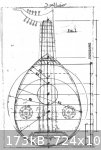
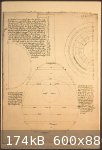
|
|
|
jdowning
Oud Junkie
    
Posts: 3485
Registered: 8-2-2006
Location: Ontario, Canada
Member Is Offline
Mood: No Mood
|
|
The second oud geometry is that of the Al- Arja oud that compares closely with a late 15th C carving of a lute in Ulm Cathedral, Germany.
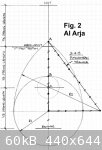

|
|
|
jdowning
Oud Junkie
    
Posts: 3485
Registered: 8-2-2006
Location: Ontario, Canada
Member Is Offline
Mood: No Mood
|
|
The third is a development of the Al-Arja oud - the Nahat oud with its elliptical shaped lower profile. The geometry of the elliptical profile is
traced using a loop of string stretched taut between two pins.
Next to analyse the profile of a late 16th C. lute.
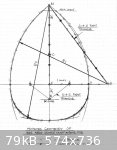
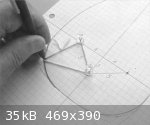
|
|
|
jdowning
Oud Junkie
    
Posts: 3485
Registered: 8-2-2006
Location: Ontario, Canada
Member Is Offline
Mood: No Mood
|
|
The first of the geometries of original lutes to be analysed is one familiar to most lute makers - a lute by Giovane Hieber, Cat. No. 1561 in the
Musee Instrumental Conservatoire Royal de Musique de Bruxelles. This rather plain instrument is considered to be in original condition. String length
591.5 mm.
Working from a full size drawing of the instrument made by luthier Stephen Murphy in 1976 the following geometry is a close match allowing for some
slight asymmetry of the profile.
The upper part of the sound board profile is identical to that of the Al Arja and Nahat ouds based upon a basic 3:4:5 unit 'Pythagorean' right
triangle XZN with a sound board width of 4 units and profile generated by an arc of radius R1with centre at Z.
Like the Al Arja oud, the front edge of the bridge is 1 basic unit from X and the bottom of the sound board F, 2 basic units from X.
Unlike the Al Arja oud, however, the lower profile is not semicircular but 'flattened - similar to the Nahat elliptical shape in appearance but
generated differently as follows:
The square ABDG has sides equal to the sound board width. Diagonals AF and BD intersect at point O the centre for an arc of radius R3 that just
touches arcs traced by R1 and R2. This profile, therefore, is not an ellipse.
As with the Al Arja geometry the location of the neck joint is determined by the fingerboard width - in this case 70 mm, just sufficient width for 7
courses. The centre of the sound hole C is then positioned midway between the neck joint and front edge of the bridge. The diameter of the sound hole
is 1/4 of the distance between neck joint and bridge.
This proposed Hieber geometry might, therefore, be considered a development of that of the Al Arja oud (which in turn is a close match to an earlier
lute geometry of the late 15th C - represented by the carving 'Pythagoras with Lute' in Ulm Cathedral).
Note that Hieber was a luthier of German origin working in Northern Italy during the 16th C - hence the Italianate 'Giovane' or 'Giovanni'.
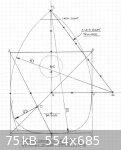

|
|
|
FastForward
Oud Junkie
    
Posts: 225
Registered: 6-2-2008
Member Is Offline
Mood: No Mood
|
|
Very nice John. I am looking forward for the rest of this. I think it would also be interesting if you include some Egyptian ouds from the late 19th
early 20th centuries. I think the shape of the bodies of these ouds is much closer to the lute's shape.
Unfortunately, I don't have any such ouds, otherwise I would be happy to provide you with the drawings.
|
|
|
jdowning
Oud Junkie
    
Posts: 3485
Registered: 8-2-2006
Location: Ontario, Canada
Member Is Offline
Mood: No Mood
|
|
Thanks Fastforward. You may well be correct in your thoughts about Egyptian ouds. They have a 'longer', narrower, almond shaped profile than the three
examples currently under consideration that might match the geometry of some (but not all) of the early 16th C lutes with similar profiles (e.g lutes
by Maler and Frei - German again!).
I have an old Egyptian oud with such a profile that has bracing that matches 16th C European lute practice so the old Egyptian style of oud is
certainly worthy of some attention - but we need more examples for comparative analysis. I have full scale drawings of some of the rare surviving
European lutes by these makers for comparison.
In the meantime, small early 17th C lutes of the extended neck type - liuto attiorbato, theorbo, tiorbinos and the like may be other examples that
look as though they may have some match to these first three oud profiles. Like the next example to follow
|
|
|
jdowning
Oud Junkie
    
Posts: 3485
Registered: 8-2-2006
Location: Ontario, Canada
Member Is Offline
Mood: No Mood
|
|
Before leaving the Hieber lute example I should mention that most of the surviving lutes of the 16th and 17th C have a bowl section that is 'flatter'
than the semi circular section commonly found in oud bowl geometry. 'Baroque' lutes of the 18th C often had 'deeper' than semi circular sections.
Also, the neck joint on lutes slope whereas on ouds the joint is vertical. This is necessary on the wider finger board lutes to ensure that neck
thickness at the neck joint does not become excessive.
I built a lute modelled on the Hieber instrument geometry in 1979 - that I still use today on a daily basis. The attached image illustrates the
'flattened' bowl section which is about
10 mm less than a perfect semicircle in section - just to make construction a bit more difficult (all of the ribs being slightly non symmetrical)!

|
|
|
jdowning
Oud Junkie
    
Posts: 3485
Registered: 8-2-2006
Location: Ontario, Canada
Member Is Offline
Mood: No Mood
|
|
Here is another example of very similar geometrical profiles between the Al Arja oud, the 'Pythagoras lute' of Ulm and an early 17th C lute.
The lute, a well preserved example of an extended neck lute - a tiorbino by an anonymous maker - is in the Cleveland Museum of Art, accession number
1918.368. A gallery of high resolution images of the lute, courtesy of Ed. Greenhood and the Lute Society of America can be viewed at:
http://www.cs.dartmouth.edu/~lsa/links/Tiorbino
The attached geometry is self explanatory in comparison with the Al Arja/Ulm and the Hieber lute profiles previously posted.
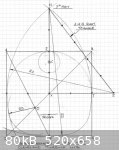


|
|
|
jdowning
Oud Junkie
    
Posts: 3485
Registered: 8-2-2006
Location: Ontario, Canada
Member Is Offline
Mood: No Mood
|
|
The next example of interest in this investigation is the Dean Castle Unverdorben 'lute-guitar' subject of topic 'Lute or Oud" on this forum.
It is assumed that there has been little or no distortion of the original profile of the bowl on this instrument since the 16th C.
Once again the geometry of the upper part of the sound board profile can be defined using a 3:4:5 right triangle as a basis. The front edge of the
original bridge is placed one basic unit from X. The centre of the sound hole C is 2.5 units from X as is the distance to N. The bottom of the sound
board F is given by R4 with centre H at the bridge
The diameter of the sound hole is 1/3 the width of the sound board at that point - a common relationship with 16th C lute geometry.
Below the widest point of the sound board, the geometry of the profile becomes a little more complicated than in previously posted geometries. The
profile is not elliptical.The attached proposed geometrical construction is self explanatory.
The slight mismatch between the arcs drawn by R1, R2, and R3 can be blended smoothly by an arc drawn by R5 with centre D, midway between X and H.
Given this proposed geometrical construction, the original bridge would have been a bit lower (and now covered by) the
19th C bridge - giving an original string length of about
66.5 cm.
The relative consistency of the results so far (old ouds and old lutes) may imply that both instruments (or at least some of them) were traditionally
designed to a strict formula based upon geometric designs easily replicated - without any knowledge of more advanced mathematics - using only
dividers as a universal simple tool. Early days yet, however, to draw any firm conclusions.
It should be noted that not all surviving lutes conform to the 3:4:5 right triangle geometrical basis and so, no doubt, neither do some old ouds.
Nobody said this was going to be easy!
One thought is that the current method of building an oud bowl "free form" without a mold (and, therefore, lacking precise, repeatable geometrical
profile) is not how it was done historically.
UPDATE 21 Nov. 2013 - the proposed sound board geometry of this lute has now been revised in the light of new information and not based upon a
Pythagorean 3:4:5 triangle. See page 5 of this thread.
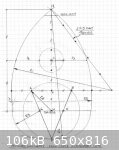

|
|
|
jdowning
Oud Junkie
    
Posts: 3485
Registered: 8-2-2006
Location: Ontario, Canada
Member Is Offline
Mood: No Mood
|
|
Most of the images of old ouds posted on this forum (and elsewhere on the Internet) do not lend themselves to precise geometrical analysis - usually
because the images are not taken 'face on' with a long focus lens and so are subject to some degree of optical distortion or are of too low a
resolution to precisely define the profiles.
Here is one example of an image of an oud by Rhoufan Nahat, 1908, that - although not high resolution - seems to have been taken pretty well face on.
I do not know who the owner is (lucky guy!).
Working with a 40% full scale scan, the geometry and construction of the lower half of the sound board profile appears to be identical to that
proposed for the 1925 Abdo George Nahat and sons oud recently discussed in "Analysis of Nahat Bracing" on this forum.
The only difference is that the Rhoufan oud has a single sound hole whereas the 1925 Nahat has a triple sound hole.
Interestingly the sound hole of the Rhoufan oud is 1/3 the diameter of the width of the sound board measured at the centre of the sound hole. This is
a proportion sometimes found on surviving lutes from the 16th and 17th C. It is also the proportion given by Arnault de Zwolle in his geometrical
construction of a 14th C lute.
An 'oversized' pair of dividers has now been made so that the profiles of the many full sized drawings of historic lutes that I have on file may be
analysed in detail.
The first step will be to identify others (if any) that conform to the now familiar basic 3:4:5 right triangle geometrical construction.
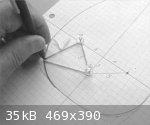
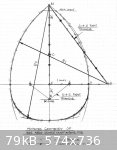

|
|
|
jdowning
Oud Junkie
    
Posts: 3485
Registered: 8-2-2006
Location: Ontario, Canada
Member Is Offline
Mood: No Mood
|
|
Working through my files and drawings of early lutes to identify any profiles that may have a geometry based on a 'Pythagorean' 3:4:5 right triangle,
I found this lute by 16th C luthier Wendelio Venere that seems to closely match this geometry. This lute, dated 1592, in the Bolognia Academia
Filarmonica, Italy is in original condition with 7 double courses and a bowl made from 25 ribs of yew. String length is 58.3 cm. The label inside
states "In Padova Wendelio Venere"
W. Venere (a luthier of German origin working in Northern Italy from about 1570) made lutes of differing geometry as can be seen in this comparison of
the 1592 instrument and another in the Dean Castle, van Raalte collection. The latter - now in a mutilated state having been crudely converted to a
'lute-guitar' in 19th C Germany has its original 13 ribbed ivory bowl with a sound board dating from either the 17th or early 18th C.
The maker labels inside trace the history. the original printed label reads " Wendelinus Tieffenbruker Dictus Venerius Fecit" with the date 1571
written in ink. The second printed label reads " Johannes Rossman/ Lauten und Geigenmacher in Breslau" with the date 1686 written in ink. The third
label reads "Christian Gottlieb Hoffmann Leipzig Anno 1726". Two other small labels are indecipherable.
So the labels tell us that luthier Wendelio Venere is non other than the renowned German lute maker Wendelin Tieffenbruker. They also tell us that the
lute went through at least two conversions during the 'Baroque' period before ending up as a 19th C 'guitar-lute'.
The attached proposed geometry of the 1592 lute is largely self explanatory being based upon a 3:4:5 right triangle. Note that the front edge of the
bridge is positioned at 1/6 of the length of the bowl NF - a classical proportion for the lute (as well as the Al Arja oud, for example). The sound
hole diameter is 1/5 of NF. The top edge of the sound hole is defined by arcs R2 and, at the centre of the sound hole, the diameter is 1/3 the width
of the sound board at that location - another classic lute proportion.
The 'cut in' rosette of the 1592 lute is oud like in design (compared to the 17th/18th C geometrical design of the Dean Castle example).
Note that there is a slight deviation from the 3:4:5 geometry at the neck joint location. This may be due to the luthier simply adjusting the profile
slightly at the neck block to fit a narrower 7 course rather than a wider 8 course fingerboard.
The proposed geometry of the 1592 lute was developed from a full size drawing by luthier Stephen Murphy. The image of the lute and drawing of the
rosette are by Stephen Murphy :
http//:www.murphylutes.com
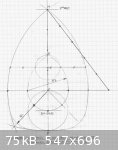
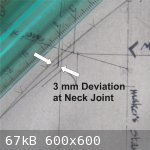
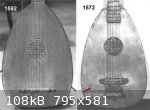

|
|
|
jdowning
Oud Junkie
    
Posts: 3485
Registered: 8-2-2006
Location: Ontario, Canada
Member Is Offline
Mood: No Mood
|
|
An old oud that I purchased in Cairo in the early 60's has so far been assumed to have been made in that city and, as a consequence, to be an Egyptian
oud. But is it?
A hand written label (in Arabic) inside the bowl translates as "School of Ornamentation, Department of Musical Instruments, made by Hosain Mohy al
Deen Helmy, Third Year". There is no date and the location of the "School of Ornamentation" is unknown.
Allowing for some asymmetry on the treble side of the bowl (about 3mm maximum) the proposed geometry attached fits the profile closely and reveals
that the sound board was fitted by the luthier about 4 mm towards the end of the bowl than it should have been. The diagram attached shows the
corrected sound board geometry.
The geometrical layout is self explanatory and, once again, is based upon the now familiar 3:4:5 right triangle. The profile of the upper part of the
sound board is defined by an arc of radius R1, the bottom part by an arc of radius R2 - both joined by an arc of radius R3. The front edge of the
bridge is located at one basic unit from X and the bottom of the sound board is 2 basic units from X.
The centre of the large sound hole is mid way between the neck joint and front edge of the bridge. The top of the sound hole is 2 basic units from X
which defines the sound hole diameter (compare this with the Al Arja geometry previously posted).
The centres of the small sound holes are each a distance of one basic unit from the sound board centre line. I was unable to find any geometrical
correlation that gives the diameter of the small sound holes so assume that their diameter was determined as simply the maximum that would fit between
the brace fitted at the widest part of the sound board (centre at X) and the brace located just below the bottom edge of the sound hole.
So the question now is does this geometry represent the traditional profile of an Egyptian oud - which is very similar if not identical to the
geometry of early ouds made in the Lebanon/Syria region?
Or is this oud not Egyptian but one that originally came from Syria or Lebanon?
The rosette designs are a bit unusual for an oud so might turn out be another clue in the puzzle.

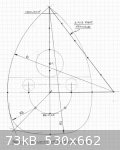
|
|
|
jdowning
Oud Junkie
    
Posts: 3485
Registered: 8-2-2006
Location: Ontario, Canada
Member Is Offline
Mood: No Mood
|
|
For information, the attached image of the bracing geometry of the old 'Egyptian' oud may be of interest - although bracing geometry is to be
considered as a separate study for the future.
This scale drawing was made in the mid 1970's - before PC's and the convenience of digital graphics - the dimensions being transferred on to squared
paper. As a consequence the geometrical profile of the sound board may lack some precision although it should be pretty close. The view is from the
underside of the sound board.
Of interest is how closely the bracing geometry matches the geometry of 'standard' lute bracing given by Marin Mersenne in his monumental theoretical
work "Harmonie Universelle", Paris, 1636.
Reviewing this drawing caused me to re-examine the sound hole geometry as the centres of the small sound holes appeared to be slightly wider spaced
than given in the previous post. Rechecking the full size dimensions confirms that this is indeed the case although the discrepancy is only about 2 or
3 mm (but a bit outside the accuracy of measurement of say plus or minus 0.5 mm).
I now think that the luthier may have intended for the relative locations of the sound hole centres to be at a 45 degree angle to each other but just
didn't get the measurements 'spot on'
The attached image shows the exact full size geometry of the sound holes.
Here are some basic dimensions for information.
String length 622 mm - six double courses. Width of neck joint 60 mm. Maximum width of sound board 349 mm and length from neck joint to bottom of the
bowl 512 mm. Maximum depth of bowl is about 182 mm so the bowl section is slightly deeper than a semicircle by 15 mm.
Note also that the bridge is 1/6th of the total sound board length (taken to the intersection of the arcs described by R1 on the geometrical
construction). This is also the proportion found on many surviving lutes from the 16th and 17th C.
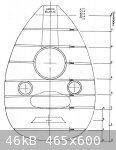
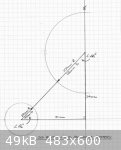
|
|
|
jdowning
Oud Junkie
    
Posts: 3485
Registered: 8-2-2006
Location: Ontario, Canada
Member Is Offline
Mood: No Mood
|
|
Danielo has kindly sent me a 'full face' high resolution image of his beautiful, yet unadorned, 1921 Hanna Nahat oud for geometrical analysis - to add
to the data base on this thread (thanks Dan). More donations would be welcomed!
Working with reduced scale images that may be subject to optical distortion has its inevitable drawbacks regarding precision of any proposed geometry
so, as more information becomes available, these proposed geometries may be subject to future refinement and revision.
The attached proposed geometry is again based upon a 3:4:5 right triangle - giving an exact fit to the upper sound board profile as defined by R1.
The front edge of the bridge - distance XB - is 3/4 of basic triangle unit. The distance to the bottom of the sound board BF is 1 basic unit.
The centre of the sound hole C is midway between the neck joint and the front edge of the bridge tie block (not the front edge of the bridge). The
bottom edge of the sound hole is 3/4 basic unit from X which in turn defines the diameter of the sound hole.
The profile of the lower part of the sound board is not parabolic but is a simpler 'pseudo parabola' constructed from a blending of three arcs
described by R2, R3 and R4.
(In the case of instrument geometry I am of the opinion that the simpler the construction the more likely it is that this may have been the original
method used by Hanna Nahat - a combination of simple arcs taking precedence over the more complex parabolic geometry).
The attached rough sketch of a Nahat bridge cross section compared to a more 'conventional' traditional oud bridge is intended to clarify the
dimensional difference between the front edge of the bridge and front edge of the bridge tie block. It would seem that the Nahat design imposes a
greater rotational torsion on the sound board - string tension being equal.

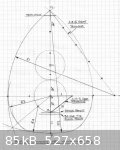
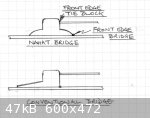
|
|
|
jdowning
Oud Junkie
    
Posts: 3485
Registered: 8-2-2006
Location: Ontario, Canada
Member Is Offline
Mood: No Mood
|
|
When working with reduced scale drawings or images, a simple tool that is a time saving aid in determining if the bottom curve of a sound board
profile is a simple arc (rather than a more complicated elliptical curve) can be made from a piece of thin 'Plexiglas' (transparent Acrylic sheet). A
series of arcs are scratched into the plastic using a pair of dividers (the exact radii are not important as the arcs are for comparison purposes
only). The centre of the arcs is then drilled out to about 0.7 mm diameter to allow a standard pencil lead to pass through in order to mark the centre
position.
In use the tool is placed over the drawing to match the arc profile and the centre marked with a pencil.
Here, a drawing of a lute made in 1644 by Pietro Railich, a German luthier working in Venice during the 17th C. is the current subject of analysis.
This instrument, Cat. # MI 45 is in the instrument collection of the Germanisches Nationalmuseum, Nurnberg.
It can be seen that the profile of the bottom part of the sound board is a simple arc not an elliptical curve.
(I am beginning to suspect that most if not all of the geometric profiles of the bottom half of historic lute and oud sound boards are not elliptical
but may be described by a series of simple arcs - using dividers - blended together to provide a uniform curve).
The next step in this study is to examine those surviving lutes (like this example by Railich) and ouds (19th C Turkish style?) that may be a
development of the 14th C. Arnault de Zwolle lute/ 13th C. Kitab al-Adwar oud geometries posted at the beginning of this thread.
More to follow.
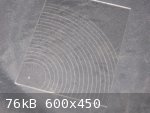
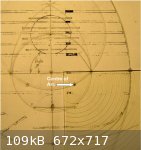
|
|
|
jdowning
Oud Junkie
    
Posts: 3485
Registered: 8-2-2006
Location: Ontario, Canada
Member Is Offline
Mood: No Mood
|
|
So far, some old ouds and lutes that fit an upper sound board profile based on a 3:4:5 'Pythagorean' right triangle geometry have been identified.
Although much more work needs to be done, to establish a more extensive data base, it is clear from the few examples already posted that the upper
sound board profile consistently defines this particular geometrical type. Lets call this type 2 geometry.
As can be seen from the examples posted, the lower sound board profile can match a variety of proposed geometries ranging from a simple semi circle to
a 'flattened' elliptical shape - or perhaps more likely - pseudo elliptical profiles constructed from simple arcs generated by a number of possible
radii and radii centres. The geometry of the lower sound board then dictates bridge location, sound hole placement and diameter(s) and bowl volume.
Furthermore, these parameters in turn then dictate relative placement of the sound board bracing (e.g. those braces positioned at the widest part of
the sound board, at the centre and on either side of the main sound hole and on either side of any additional small sound holes).
It is likely, therefore, that individual luthiers - choosing to use the type 2 geometry - may have then varied the lower profile in order to achieve
particular acoustical characteristics from their instruments.
Note that the air volume of the bowl can also be modified by changing the cross section from a semi circle to a more 'flattened' profile (often found
in lutes of the 16th and 17th C) or a deeper profile (often found in lutes of the early 18th C or 19th/ early 20th C ouds). As no ouds survive from
the 16th/ 17th C it is impossible to determine if they, like the lutes, ever had a flattened profile.
The next geometry to be investigated is most likely an earlier type so lets call it type 1. This is the geometry of the 13th C Kitab al Adwar oud/
14th C Arnault de Zwolle lute. Again, the upper sound board profile defines the geometrical type - in this case an arc described by a radius equal to
the maximum width of the sound board. Like the type 2 geometries, the lower sound board profiles may range from a semi circle to a more complex
elliptical or pseudo elliptical shape with all of the consequential acoustical implications mentioned above.
Before moving on to specific examples of type 1, the attached image compares - side by side - two basic examples of type 1 and type 2 drawn to the
same scale. Here the type 1 example is the Arnault de Zwolle geometry with the length of sound board divided into 6 equal parts, the bridge located on
the first part and top of sound hole at the 4th part, Sound hole diameter is 1/3 the width of the sound board at the sound hole centreline.
The type 2 example, for comparison, is that of the late 15th C carving of a lute in Ulm cathedral. Here the sound hole diameter is 1/4 the maximum
sound board width.
Surviving lutes that match the type 1 geometry are in the minority but two potential examples will be examined next. As for the ouds, I suspect that
the traditional design of Turkish ouds might also conform to type 1 geometry - but that has yet to be established as I note - on preliminary
examination - that old Turkish ouds seem to vary greatly in their geometric profiles.
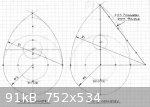
|
|
|
Yaron Naor
Oud Junkie
    
Posts: 275
Registered: 1-24-2009
Location: Bat Hefer, Israel
Member Is Offline
Mood: Happy
|
|
Thanks
Thanks for publishing all this valuable information, I really learn a lot from you
Thanks,
Yaron.
|
|
|
jdowning
Oud Junkie
    
Posts: 3485
Registered: 8-2-2006
Location: Ontario, Canada
Member Is Offline
Mood: No Mood
|
|
Thanks Yaron - glad that it is of interest.
|
|
|
jdowning
Oud Junkie
    
Posts: 3485
Registered: 8-2-2006
Location: Ontario, Canada
Member Is Offline
Mood: No Mood
|
|
The first example of a lute that fits the type 1 geometry is in the musical instrument collection of the Germanisches
Nationalmuseum, Nurnberg - cat. MI 55. Made by Christofolo Hoch, Venice, first half (?) of the 17th C. I am not certain about the details but this
German luthier's original name may have been Christopher Koch later becoming the Italianate Christoffolo Hoch or Choc or Choco when working in
Northern Italy during the 17th C. The geometry of this lute is only one of a several used by this maker.
I do not have any images of this lute and have developed this geometry from a half full size museum drawing of the sound board and its bracing
(copyright restrictions prevent posting of the drawing).
In order to simplify the geometrical construction so that it is pretty well self explanatory, it has been broken down into three steps.
Step 1. The maximum sound board width VZ is divided into 4 equal parts VW, WX, XY and YZ. The profile of the upper part of the sound board is
described by an arc of radius R1 (equal to the sound board width) with centres at V and Z.
The vertical axis of the sound board is first divided into three parts with an arc of radius R3 (equal to half the sound board width) and centres at W
and Y. Each of the three parts is in turn equally divided to give a total of 6 equal parts LM, MN, NO, OX, XP and PQ. The bottom of the sound board is
located at point Q, the front edge of the bridge at P and the top edge of the sound hole at N. The profile of the bottom edge of the sound board is
described by an arc of radius R2 (of length LQ) with centre at point L.
Step 2. With the top edge of the sound hole at N, distance XO is divided in two to give the bottom edge of the sound hole at point B. This then
defines the centre of the sound hole (mid way between N and B) and sound hole diameter NB.
Step 3. With the centre of the sound hole established, the distance CY (R4) gives the third arc defining the remainder of the profile of the lower
part of the sound board. The centre of the third arc is quickly found - by trial and error - using dividers so that the arcs defined by R1, R2 and R4
blend together.
So it can be seen that the entire geometry can be constructed using only a straight edge and pair of dividers.
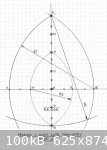
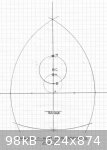
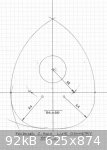
|
|
|
jdowning
Oud Junkie
    
Posts: 3485
Registered: 8-2-2006
Location: Ontario, Canada
Member Is Offline
Mood: No Mood
|
|
A second example of a lute with a 'type 1' geometry is that of an instrument by Pietro Railich made in Venice in 1644. The lute is in the instrument
collection of the Germanisches Nationalmuseum, Nurnberg, cat. MI 45.
The label inside reads "Pietro Railich gioia Venetia 1644".
Railich was born in 1615 in Fussen, Germany, later setting up his workshop (Bottega di Lautaro al Santo" in Padua, Italy where worked until his death
in 1678.
The lute has a string length of 61.4 cm with 11 courses - 2 single the remainder double.
The bowl section is significantly 'flattened' by about 32 mm at the widest part.
The pattern of the 'cut in' rosette is oud like.
Unfortunately, I do not have an image of the lute on file.
The geometry that follows is only one among other different types used by this luthier.
Working with a half scale drawing of the sound board there appeared to be a discrepancy in the vertical axis coordinates that could not be fully
resolved at the reduced scale (a disadvantage of trying to establish instrument profiles from reduced scale images).
However, it was possible to resolve this apparent discrepancy by working with a full scale drawing of the lute made by luthier Stephen Murphy that I
have on file (Stephen also drew the rosette pattern posted here).
To clarify the proposed geometry, the construction has been broken down into 3 steps - the whole geometry being created using only a straight edge and
dividers.
The procedure will be described in the next posting later this evening.
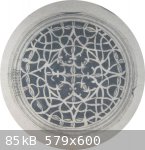
|
|
|
jdowning
Oud Junkie
    
Posts: 3485
Registered: 8-2-2006
Location: Ontario, Canada
Member Is Offline
Mood: No Mood
|
|
Here is the proposed Railich lute geometry - mostly self explanatory.
Step 1 - the maximum width of the sound board VZ is divided into 4 equal parts VW, WX, XY and YZ. The upper and lower sound board geometries are
initially constructed separately before being combined together.
Radius R1 (equal to the sound board width VZ) describes the arc of the upper sound board meeting at point L, the top of the sound board profile.
The vertical axis of the upper sound board as far as L is also divided into 4 equal parts. Point C is at one unit from X on the horizontal axis. Note
that a horizontal axis unit is larger than a vertical axis unit.
R5 describes a secondary arc giving the profile at the neck joint location.
For the lower part of the sound board geometry
R3, equal to 2 horizontal axis units, describes arcs that meet at point Q - the bottom of the sound board profile. Distance QX is divided into 2 equal
parts to give the position of the front edge of the bridge - each part is identical in length to the vertical axis units already established for the
upper part of the sound board.
R4 - equal to 1 horizontal unit - crosses the vertical axis at point C.
R1 describes the profile of the outer edges of the lower sound board.
Step 2 - the geometrical layouts of the upper and lower sound board are combined together so that points C coincide. C is then the centre of the sound
hole. The sound hole diameter is equal to 1 unit of the horizontal axis (i.e. same length as radius R4 or 1/4 maximum sound board width.
It can be seen that the alignment of point C results in a slight elongation of the total vertical axis LQ of the sound board (by about 16 mm in this
case) This is the apparent discrepancy in the vertical dimension previously noted.
Radius R2 then defines the profile of the bottom edge of the sound board.
Step 3 - Radius R6 is measured from C to point W or Y on the horizontal axis of the lower part of the sound board. By trial and error, using dividers,
R6 describes an arc that blends with R1 and R2 to complete the profile of the lower part of the sound board.
Other possible contenders for lutes of type 1 geometry have been identified but have yet to be subject to analysis.
Next - to try to find examples of early oud that also fit type 1 geometry.

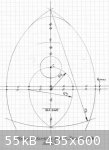
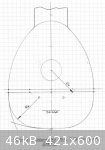
|
|
|
jdowning
Oud Junkie
    
Posts: 3485
Registered: 8-2-2006
Location: Ontario, Canada
Member Is Offline
Mood: No Mood
|
|
Turkish Oud Geometry.
Checking the images of some early Turkish ouds posted on the Internet indicates that some appear to conform in profile to
type 1 geometry.
However, in an article about Turkish instruments posted about 5 years ago on the website 'Musik ve Bilim', information giving the relative dimensions
of a Turkish oud in its four traditional sizes (girl, woman, boy and man - respective string lengths 54, 55.5, 57 and 58.5 cm) - is included as well
as a sketch (that appears to be drawn to scale and otherwise proportionally correct) giving a profile of the oud.
Using this sketch as a starting point in this examination of Turkish oud profiles, the attached image is a proposed geometry constructed according to
this data.
The geometry is largely self explanatory and may be constructed using only a straight edge ruler and a pair of dividers.
What is immediately apparent is that the oud profile is not type 1 but a type 2 geometry based upon the now familiar 3:4:5 right triangle.
If the length of the finger board is X then the distance from neck joint to the centre of the main sound hole is also X as is the distance from the
sound hole centre to the front edge of the bridge (i.e. string length is 3X). The front edge of the bridge is a distance 0.5X from the bottom edge of
the sound board.
The width of the sound board at the widest point is equal to 4 units of the 3:4:5 triangle. The diameter of the main sound hole is 1 unit and the
small sound holes 0.5 unit. The centreline of the small sound holes is distance B from the widest part of the sound board which is also half the
distance from the widest point to the bottom edge of the sound board. The spacing of the small sound hole centres is given by R3 and the distance
between sound hole centres R4 is equal to the radius of the arc connecting arcs R1 and R2 to form the profile of the lower sound board. The centre of
the arc described by R4 is quickly found - by trial and error - using dividers.
Next to examine the geometry of some old Turkish ouds from their images.
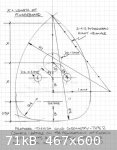
|
|
|
Danielo
Oud Junkie
    
Posts: 365
Registered: 7-17-2008
Location: Paris
Member Is Offline
Mood: No Mood
|
|
Hi John,
in the case you don't know it, here is the site of the luthier Christian Rault with several interesting articles about the history of stringed
instruments
http://prolyra.free.fr/Christian_Rault_luthier/pages/30publications...
Look in particular this one (sorry, in French!)
http://prolyra.free.fr/Christian_Rault_luthier/pages/30publpag/art0...
regards,
Dan
|
|
|
jdowning
Oud Junkie
    
Posts: 3485
Registered: 8-2-2006
Location: Ontario, Canada
Member Is Offline
Mood: No Mood
|
|
Thanks for the link Dan.
No, I was not previously aware of this article by Christian Rault so it is interesting to look at an independent analysis of the Arnault de Zwolle
lute and Safi al Din oud drawings from a somewhat different perspective other than the one I have proposed in the recent topics on this forum "
Analysis of an Early Oud Wood cut" and "Old Oud - New Project".
While I agree with some of the conclusions in the article, I have a hard time accepting those that seem to ignore the evidence presented in the
drawings and , therefore, (in my opinion) must cast doubt on the author's attempt to demonstrate a consistent connection between the geometric and
harmonic proportions (1/2 for the octave etc.).
Nevertheless, it is perhaps a useful reminder to exercise caution before arriving at positive conclusions based on reduced scale drawings as is the
case with both the Arnault de Zwolle and Safi al-Din examples.
For example, when the lute is drawn 'full size' - according to the instructions and proportions given in the original manuscript - the sound hole
diameter is not 1/3 the width of the soundboard at that location (it is somewhat smaller) and the top of the sound hole (and the brace at that
location) is not positioned exactly at 5/6 of the body length. The 'odd' length of the neck (too long to fit on the paper states Arnault de Zwolle) is
given precisely in the manuscript as equal to the maximum width of the sound board (but this does not equate to half the vibrating string length as
proposed by Christian Rault).
A further complication in interpreting the original lute drawing is that it is a composite showing both the geometry of the sound board superimposed
over the design of the mold - with no allowance provided for the thickness of the ribs.
Likewise, the length of the neck of the oud - judging from the relative proportions of the oud engraving - is very close to being 1/3 string length -
the classical proportion still used today on ouds. This does not equate to a fingerboard length measuring 3/8 of the total length of the oud as
proposed by Mr Rault and it is also clear from the engraving that the length of the bridge does not correspond to half the maximum width of the sound
board.
Nevertheless, despite these reservations, I would agree that the geometrical construction of each of the instrument sound board profiles is valid,
that it can be assumed that the lute sound hole diameter should be 1/3 of the width of the sound board at that location and the front edge of the
bridge should be placed at 1/6 of the bowl length (Arnault de Zwolle says they should be). I also agree with the oud sound hole geometry (diameters
and placement) proposed by Mr Rault.
There is still some uncertainty about the provenance of oud engraving. Apparently it can be found in a manuscript copy dated 1333/4 in the Bodleian
Library, Oxford, England. It is not known at present if this drawing is unique to this particular manuscript copy - added perhaps by the scribe over
30 years after the death of Safi al-Din? I have a scanned copy of the Kitab al-Adwar but the engraving is not in evidence there.
Safi al-Din was of Persian origin and lived out his life in Iran and Iraq. So could this design of oud have been representative of 14th C oud design
in Moorish 'Spain' as well as Persia (and Turkey?) arriving in the hands of Arnault de Zwolle from the Iberian Peninusula via France (as many believe)
or did it come directly from, say, the Ottoman Empire via a connection with the German states of the time (Holy Roman Empire).
We know nothing about the 14th C Moorish oud but some clue about its design might be evident in the design of old examples of the Tunisian four course
fretted 'oud arbi' (which - at first glance - does not appear to conform to the Arnault de Zwolle or Safi al-Din designs).
More to follow!
|
|
|
jdowning
Oud Junkie
    
Posts: 3485
Registered: 8-2-2006
Location: Ontario, Canada
Member Is Offline
Mood: No Mood
|
|
Although there are a number of old Turkish ouds surviving from the 19th/ early 20th C the difficulty - as far as this study is concerned - is to
obtain full face, high resolution images for analysis. Most images posted on the Internet and on this forum are usually 'taken' at an angle, are
'thumbnail' size (poor definition), or protected against downloading/copying so are not suitable for use in this study.
Of primary interest for this next step are images of old Turkish ouds that fall into the Type 1 geometry category. Present day Turkish ouds seem to be
made to either Type 1 or Type 2.
Forum member Jonathan has a number of images of old ouds by Armenian luthiers posted on his website at:
http://www.varjouds.com
Some of the images are sufficiently well defined to allow a preliminary geometrical analysis - even if this is only to confirm a Type 1 geometry.
These will be checked out at a later date as time permits. These are the oud makers and examples of their instruments of interest in this respect:
HAGOP KUCHUKIAN (1910, Istanbul)
OHANNES UZUNYAN (1908)
ONNIK ZADORAVYAN (1927)
ARMENAK KALFAYAN (1826)
SAHAK KAPLANYAN (1905)
KRIKOR KAHYAYAN (1919, Istanbul)
LEON ISTANBULI (1940, Lebanon)
ARTIN ATIKYAN (1936, Istanbul)
AGOP GURDIKIAN (1920)
To this list can be added ouds by MANOL.
However, before examining the above Turkish ouds in more detail it might be useful and of interest to first analyse images of two 19th C 'Egyptian'
ouds in the collection at the Musical Instrument Museum (M.I.M.) in Brussels - #0164 and #0404 acquired by the museum in 1871 and 1879 respectively -
so the instruments are certainly from the second half of the 19th C but were likely made quite a bit earlier than the museum acquisition dates (by 50+
years?).
First to examine the images of oud # 0164 as it seems to be of Type 1 geometry
|
|
|
| Pages:
1
2
3
..
5 |